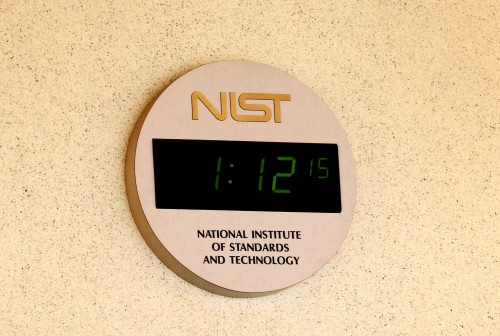Tag archives: fundamental constant
Setting the standards for physics

Keepers of time: at the NIST campus in Gaithersburg. (Courtesy: Tushna Commissariat)
By Tushna Commissariat in New York City, US
As most of our regular blog readers will know, last week Physics World‘s Matin Durrani and I were in Baltimore attending the APS March meeting. While we spent most of the week at the conference centre, last Friday we visited the National Institute of Standards and Technology’s (NIST) Gaithersburg campus, as well as the Joint Quantum Institute (JQI), which is based at the University of Maryland. It was a jam-packed, exciting day that we spent zipping around to and from more than 10 different labs and departments, meeting people who use physics to do everything from improve the safety of body armour to redefining the kilogram.
As we saw so many interesting projects, covering them all would make for a rather long read. Instead, join me for a quick visual tour of NIST below (I will cover our JQI visit in a separate blog) to get a small taste of the physics and people involved.
Is the fine structure constant affected by gravity?

Artist’s illustration of a white-dwarf star (Image Courtesy: NASA/JPL-Caltech)
By Hamish Johnston
If there is one thing our readers like it’s a good story about fundamental constants – and the fine structure constant (α) is always a favourite.
In case you are not familiar with α, it’s a dimensionless quantity (about 1/137) that measures the strength of the electromagnetic interaction. As such, it quantifies how electrons bind within atoms and molecules and therefore can be measured to great precision using spectroscopic techniques. And because atoms can be found just about anywhere between here and the edge of the universe, it’s possible to ask whether α is the same everywhere.
In a paper published this week in Physical Review Letters, an international team of physicists have measured α in the atmosphere of a white-dwarf star – where the gravitational potential is about 30,000 times greater than here on Earth.
View all posts by this author | View this author's profile
Alpha might vary across the universe

A look into the anatomy of a quasar’s spectrum (Credit: Michael Murphy, Swinburne University of Technology/NASA/ESA)
By Tushna Commissariat
A paper published in Physical Review Letters this week talks about how one of the fundamental constants of our universe – the fine-structure constant (α) – may vary across the universe. If you feel like you have heard something about this before, that is because the researchers have been looking into this particular phenomenon for almost a decade now.
They published a pre-print of this work on the arXiv server in August 2010, but the paper was only published in PRL yesterday, the delay perhaps reflecting how profound the finding could be.
The constant α is a combination of another three constants – the speed of light “c”, the charge of an electron “e” and Plank’s constant “h” – and is given by α = e2/hc.
John Webb and colleagues first looked at the light coming from very distant quasars in 1999, using the Keck Observatory in Hawaii and more recently the Very Large Telescope in Chile, to see if α really was a fundamental constant or if it varied with time or space. They use distant quasars simply as light sources that span across billions of light years. The spectrum of the quasar light carries an imprint of atoms in gas clouds that the light traverses through on its way to Earth. These spectral “fingerprint” absorption lines (known as “metal absorption lines”) are then compared with the same fingerprints found in laboratories here on Earth to infer any changes to α.
What the researchers found, after looking at the light from almost 300 quasars (as of 2010) was that α was decreasing in one direction as seen from the Earth and increasing in the exactly opposite direction. This asymmetry in the two hemispheres has been dubbed the “Australian dipole” by the researchers and has a statistical significance of about 4 σ. While some scientists were sceptical of the finding in 2010, others called it “the news of the year in physics”. If the discovery is confirmed, it would have profound implications on our understanding of the universe and on many of our current cosmological theories.
If you would like to refresh your memory about the paper or find out what it’s all about, take a look at the news story written by Hamish Johnston last year here, or take a look at the feature article written for Physics World by lead author of the paper, John Webb, here.
View all posts by this author | View this author's profile